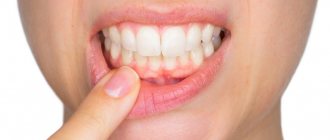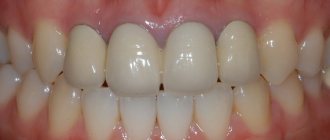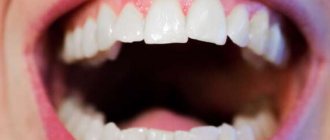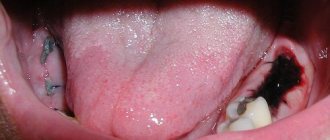For many people, wisdom teeth have difficulty erupting because they do not have enough space in the jaw. In this case, dentists recommend removing them to prevent crooked teeth and other problems. Extraction of third molars is a complex operation that must be performed by a highly qualified dental surgeon.
After surgery, it is important to follow your doctor's recommendations.
- For the first few days after surgery, you should not rinse your mouth or drink through a straw, as this may wash out the blood clot covering the wound.
- Brush your teeth with a soft-bristled brush and eat only soft foods to avoid damaging the socket.
- Minimize physical activity, do not visit the sauna or take a hot bath.
- If the pain is severe, take painkillers. To relieve swelling, you can apply ice to your cheek.
- Stop drinking alcohol and smoking.
It is important to monitor the wound remaining at the site of the extracted tooth until it heals completely.
What does the white coating mean?
Did you find that your gums turned white after wisdom tooth removal? There is no cause for concern as this is normal. White plaque may be on the hole and around it. The reason for its appearance is fibrin, a protein that ensures tissue regeneration. It performs several functions:
- prevents bleeding,
- closes the wound and protects it from bacteria,
- helps reduce the diameter of the hole,
- accelerates the resorption of a blood clot.
White plaque cannot be removed. Because of this, pain increases and the wound healing time increases. Damage to the protective film can lead to severe bleeding and infection of the socket.
Average cost of treatment in Moscow
| Name of service | Cost, rub. |
| Dentist consultation | 600 |
| Periodontist consultation | 740 |
| Consultation with an implantologist | 820 |
| Treatment of complications | |
| Removing dental plaque in the area of 1 tooth | 180 |
| Periodontal applications in the area of 1 tooth | 370 |
| Application of a protective periodontal bandage | 400 |
| Closed curettage of periodontal pockets | 900 |
| Open curettage of pockets | 1300 |
| Flap surgery | 3000 |
| Implant removal | 6900 |
| Implantation of osteoconductive material in the area of 1 tooth | 10900 |
| Implantation of a protective membrane (1 tooth) | 12900 |
Possible complications
In rare cases, white gums after wisdom tooth removal may indicate the development of complications.
- Alveolitis. Inflammation of the socket due to infection by pathogenic microorganisms. The causes of development include non-compliance with personal hygiene rules and doctor’s recommendations. The main clinical manifestations are throbbing pain, gray plaque on the wound, and swollen lymph nodes.
- Periostitis. Inflammation of soft tissues and periosteum. Develops due to poor quality dental treatment and jaw injuries. It is a small growth on the gum that can be red, yellow or white.
Clinical researches
As a result of clinical experiments using the Asepta series of products, which were carried out at the Kazan State Medical Academy N.V. Berezina, E.N. Silantieva, S.M. Krivonos, the effectiveness of the Asepta line of drugs has been proven as a means of etiotropic and symptomatic therapy as part of the complex treatment of patients with chronic inflammatory periodontal diseases.
Sources:
- The use of drugs from the Asepta line in the complex treatment of inflammatory periodontal diseases (N.V. Berezina E.N. Silantyeva S.M. Krivonos, Kazan State Medical Academy. Kazan.) N.V. BEREZINA, E.N. SILANTIEVA, S.M. KRIVONOS Kazan State Medical Academy
- The effectiveness of the use of Asept “adhesive balm” and Asept “gel with propolis” in the treatment of chronic generalized periodontitis and gingivitis in the acute stage (Municipal Dental Clinic No. 4, Bryansk, Kaminskaya T. M. Head of the therapeutic department Kaminskaya Tatyana Mikhailovna MUZ City Dental Clinic No. 4, Bryansk
- The effectiveness of the use of Asepta balm in the treatment of patients with inflammatory periodontal diseases (Doctor of Medical Sciences, Professor Elovikova T.M., Department of Therapeutic Dentistry, USMU. Yekaterinburg) Doctor of Medical Sciences, Professor Elovikova T.M. Department of Therapeutic Dentistry, USMU. Ekaterinburg
- Report on clinical trials to determine/confirm the preventive properties of commercially produced personal oral hygiene products: mouth rinse "ASEPTA PARODONTAL" - Solution for irrigator." Doctor of Medical Sciences Professor, Honored Doctor of the Russian Federation, Head. Department of Preventive Dentistry S.B. Ulitovsky, doctor-researcher A.A. Leontiev First St. Petersburg State Medical University named after academician I.P. Pavlova, Department of Preventive Dentistry.
When do you need a doctor's help?
If you experience pain 3-5 days after wisdom tooth removal, you should consult a specialist. Reasons to visit a dentist are also:
- accumulation of pus in the wound,
- bad breath,
- increase in body temperature,
- bleeding gums,
- swelling of the lip or cheek,
- pain when eating.
Don't expect unpleasant symptoms to disappear. Contact your doctor even if you experience minor oral discomfort.
Symptoms and treatment of leukoplakia -
Leukoplakia is characterized by the fact that under the influence of various irritants, keratinization of the epithelium of the oral mucosa begins to occur. This process occurs due to a violation of the desquamation of the epithelium in those areas of the mucous membrane that is exposed to pathological irritants. These irritants can be:
- smoking,
- sharp edges of carious teeth,
- overhanging edges of fillings,
- malocclusion,
- excessive consumption of spices, very hot foods,
- poorly manufactured removable dentures,
- the presence of artificial crowns made of different metals on the teeth, which gives rise to galvanic currents in the oral cavity.
White spots on the gums with leukoplakia: photo
Symptoms of leukoplakia:
The main element of leukoplakia is a white plaque, which may rise above the level of the mucous membrane, but may not rise (as in Fig. 4). In addition, the plaque can have both clear and blurred boundaries. Patients most often call such plaques white spots. As a rule, white spots do not bother their owners and are discovered completely by accident.
In some cases, patients may be concerned about the roughness of the mucous membrane at the site of the white spot, as well as the fact that the mucosa in this place may rise above the level of the mucosa. In some cases, cracks and ulcers may appear on the surface of the stain; in this case, the patient may also be bothered by burning and pain. If leukoplakia develops as a result of smoking, then, as a rule, patients first of all complain of dryness and burning of the oral mucosa (24stoma.ru).
Treatment of leukoplakia will primarily involve eliminating exposure to the irritating factor. Those. it will be necessary to eliminate the impact of the overhanging edge of a filling or crown, replace old low-quality dentures, normalize oral hygiene, and of course, solve something with the effects of nicotine and hot dry air on the mucous membrane (which occurs when smoking).
Only after this are prescribed keratolytic agents for topical use (3-5-10% salicylic acid, celandine infusion), and vitamin therapy. Applying any treatment procedures without eliminating the causative factor will be useless.
The danger of leukoplakia –
Leukoplakia belongs to the category of precancers. Malignancy of leukoplakia, i.e. its transition to cancer occurs in 15-75% of cases (depending on its form). Therefore, if you do not want to develop cancer of the oral mucosa, you need to urgently go to the dentist and look for the cause of its appearance. But in the photo below you can see photos of two clinical cases when leukoplakia transformed into a malignant tumor of the oral mucosa and the red border of the lips.
Cases of cancer associated with leukoplakia –
What do pale gums on a dog mean?
Healthy mucous membranes
The color of a dog's gums is one of the most important indicators of a pet's health.
The gums play the role of a protective barrier in the dog's body. If you feel well, your gums will be pink or light pink. However, if your dog is feeling unwell, changing gum color can help spot and prevent the threat. Examine your pet's healthy gums while the dog is awake and at rest. Take a good photograph of your gums in good lighting. This way, if there are problems, you can quickly demonstrate to your veterinarian why the color of your gums is causing you concern.
Each dog's gum color is different. If, in good health, the gums of your four-legged friend are not pink, but slightly darker or lighter and have always been this way, then this is the norm specifically for your pet. Many dogs have partially dark gums; in this case, use the color of the unpigmented areas as a guide.
Check your dog's gums and teeth regularly. Healthy gums feel moist and slippery to the touch. When you press on the gum, it turns pink again within two seconds. This is a sign of good capillary circulation.
Not only gums and oral tissues, but also other mucous membranes can tell about the dog’s condition. If you suspect something is wrong, evaluate the appearance of the visible mucous membranes of the pet’s eyes, ears and genitals.
When you need urgent help
What does pale gum color on a dog mean? About the need to assess her well-being: are there any other alarming symptoms, were there any injuries or incidents that could harm your pet? If the gums are unhealthy, exclude rough and cold foods from his diet.
Pale gums in a dog are not a disease, but a possible signal of illness. The diagnosis can be made by a veterinarian based on a combination of symptoms, tests, examinations, and the patient’s medical history.
Pale gums can be a symptom of many different diseases. This list includes heart failure, gastric dilatation, and the presence of a foreign body in the respiratory tract. Therefore, it is important to understand exactly what reason affected the appearance of the gums.
White gums may indicate anemia (anemia), as well as blood loss, internal bleeding, intoxication, infection with internal parasites, insufficient oxygenation of the blood, or lack of hemoglobin, an iron-containing blood protein. Gum color that is too light in dogs can be caused by pneumothorax, an accumulation of air in the pleural cavity that interferes with normal lung function and gas exchange during breathing.
Pale gums may be accompanied by lethargy, apathy, poor appetite, refusal to walk and play, cough, shortness of breath, and changes in body temperature. Such symptoms indicate that the dog urgently needs to be shown to a veterinarian. An unnaturally light color of the gums may indicate a pet’s deep state of shock - in such a situation, the help of a doctor is also needed. You won't be able to figure out what's wrong on your own. Therefore, take your pet to a veterinarian as soon as possible.
If your pet loses consciousness, first call your veterinarian and describe the situation. The specialist who sees your pet will instruct you on the necessary measures.
Delay and attempts to independently help your pet at home are extremely dangerous. But if your pet cuts itself, then before visiting a doctor you should treat and bandage the wound to stop the bleeding.
Mandatory visit to the veterinarian
If your dog is alert, active, sociable and eating well, pale gums will still be a sign that you need to take your pet to the veterinarian. Not urgently, but in the near future. It can be assumed that in this case we will talk about replenishing the lack of vitamins in the body and preventive measures. Sometimes the prerequisites for the development of anemia in a pet are a lack of iron and folic acid.
Be careful when walking your dog. The gums may become pale if the pet is cold and if the dog eats snow. If after a walk in frosty weather your dog’s gums turn pale, take him into a warm room, warm him up, and give him a warm drink. Place a heating pad or a bottle of warm water under your side. Stroke the dog's fur, calm it down, talk to it kindly. If it is only a slight hypothermia, the gums will soon return to a healthy pink color.
We wish your pets health!
Questions about prosthetics
Elena
2018-11-17 15:17:00
Hello! I have had temporary plastic crowns for a year and a half now, 8 teeth on the upper jaw and 5 below. The teeth are all cured, some have inlays. These crowns have already been removed and filed several times, the top one is already broken, they glued it together. The orthopedist is in no hurry to do his job, makes an appointment once every month and a half. About five months ago, I began to experience constant itching and a feeling of fullness in the upper jaw, in the place where the crowns are located. Two months ago, it became painful to press on the gum above one tooth, there was no redness as such, and until recently I had a rash on my wrists and elbows, it went away after taking enterosorbents. I have a general malaise and my lips are constantly dry, maybe it has nothing to do with the problem of my teeth. The doctor himself says that wearing plastic is very harmful and at the same time it’s dragging. the itching was bothering me. I have a question for you, is this an inflammatory process or what could it be? I read that plastic releases a monomer that has a toxic effect. What can be done in my case. Thank you if you don’t ignore my question
Shinberg Oleg Emilievich
chief consultant, orthopedic dentist
Dear Elena, it is indeed very harmful to use temporary plastic crowns made by polymerization for a long time, and indeed, they emit a monomer that is harmful to the gums. Therefore, it is completely incomprehensible to me why your doctor is delaying so long with the manufacture of permanent structures. At a minimum, it is necessary to replace your temporary crowns with temporary crowns made by milling. They do not release monomer, because blanks for milling are made in the factory. Unfortunately, I can’t give any more advice without an examination and consultation, since the cause may not be isolated. In any case, I recommend changing your dentist, because, for some reason, he is clearly not interested in you.
Natalia
2018-10-05 17:02:00
Good afternoon, the 5th tooth is broken, only the root remains. What can be done with it? Or just an implant? Tooth from above
Shinberg Oleg Emilievich
chief consultant, orthopedic dentist
Dear Natalya, in your case there are two options: either tooth extraction followed by implantation and making a crown, or preserving the tooth root and then making a crown. This will depend on the level of the root fracture. Unfortunately, it is impossible to answer the question more accurately without consultation and an x-ray.
Natalia
2017-12-07 18:06:00
Good afternoon I am replacing the upper chewing teeth. It is necessary to place 4 units on teeth 14,15,16,17. The doctor recommends all-ceramic veneers. Initially they planned simple crowns, but today I’m convinced. I doubt it. I read that it is not advisable to put veneers on chewing teeth: they are expensive and less reliable. Is that true? There are no problems with gums or allergies to metal ceramics. The price of a veneer is of course more expensive. Thanks in advance for your answer.
Shinberg Oleg Emilievich
chief consultant, orthopedic dentist
Dear Natalya, good afternoon! The advantage of veneers over crowns is that they require much gentler preparation. Veneers, unlike crowns, do not cover all surfaces of the tooth and the thickness of the walls of the veneer is much thinner than the walls of the crown. As for the reliability and strength of veneers, modern materials make them even more durable and reliable than those on a metal-ceramic crown. Therefore, contraindications for installing veneers on chewing teeth are no longer relevant today. Of course, the price of a veneer is higher than that of metal-ceramic crowns, but the price is compensated by the greater reliability of the veneer and the durability of the structure.
Catherine
2017-11-07 20:52:00
Hello! I would like to know how much it will cost to install ceramic veneers? Thank you.
Shinberg Oleg Emilievich
chief consultant, orthopedic dentist
Good afternoon Ekaterina! The cost of making a ceramic crown (veneer) is 54,000 rubles.
Varvara
After visiting the dentist, it turned out that I would have to have a sinus and implantation of 2 teeth. I'm terribly afraid of the dentist, but I still have to do it. I’ve heard a lot about dental treatment in a dream, but I don’t quite understand how this happens and what the consequences might be after this method of treatment. I would like to consult an experienced specialist on this issue. Tell me if there are any contraindications for carrying out such a procedure and whether you will feel lethargic and drowsy afterwards. I drive all the time, so I want to know if I will be able to drive a car after leaving the office and how will I feel after that?
Shinberg Oleg Emilievich
chief consultant, orthopedic dentist
Dear Varvara, treatment in dreams really does exist, and indeed this method can almost completely relieve stress from people who, like you, are terrified of the dentist. The procedure takes place with the participation of an anesthesiologist and is completely safe. As for the question of being able to get behind the wheel immediately after leaving the office, this is categorically not recommended.
Leukoplakia
You may be interested: 8 main enemies of tooth enamel
With oral leukoplakia, uniform white spots may appear on the gums. The cause of this condition is unclear, but alcohol, smoking and poor oral hygiene are suspected to be to blame. In most cases the condition is harmless, but sometimes it can become cancerous over time.
Symptoms
In addition to visual changes in soft tissue, the following symptoms may occur:
- pain when eating and brushing teeth;
- itching;
- swelling of the mucous membrane;
- the appearance of bleeding;
- abundant plaque on the teeth and the appearance of mineralized deposits.
Symptoms depend on the cause of the pathology and on the individual characteristics of the patient’s body. Eliminating cyanosis of soft tissues is the first step in treatment and in making the patient feel better.
When to seek help from a specialist
- The blue color of the gums does not subside for more than four to five days;
- Blue discoloration is accompanied by swelling and bleeding;
- Acute pain appears that is not relieved by painkillers;
- Body temperature can rise to 38 - 39 degrees;
- Loss of strength, general weakness.
Ignoring the disease is fraught with the development of serious complications, including the formation of an intraoral cyst.
Gum structure
According to physiological and clinical characteristics, the gums are divided into three zones:
- marginal, which covers the cervical area of the tooth and has a smooth surface. The width of this part is 0.8–2.5 mm;
- attached (alveolar). It is fused with the alveolar bone, has a width of 1–9 mm and is lined with stratified keratinizing epithelium;
- free (marginal), located between the teeth and called “interdental papillae,” which normally have a triangular shape. The area adjacent to the tooth is covered with non-keratinizing epithelium.
The basis of the connective tissue of the gums is made up of cells, proteoglycans, fibers and blood vessels. Collagen fibers ensure tight compression of the gums to the tooth, continuity of the dentition and distribution of the load of chewing pressure. The presence of elastic fibers is observed in the perivascular zones.











